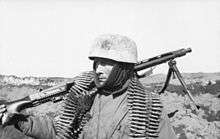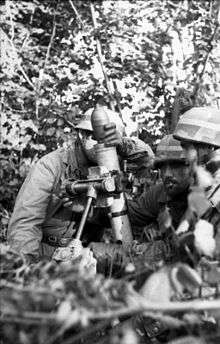Fallschirmjäger (World War II)
| Fallschirmjäger | |
|---|---|
 Fallschirmjäger with MG 42 in the Soviet Union, 1943. | |
| Active | 1935–1945 |
| Country |
|
| Branch | Luftwaffe |
| Type |
Paratrooper Infantry |
| Part of | Luftwaffe |
| Garrison/HQ | Berlin |
| Nickname(s) | "Green devils" |
| Engagements | World War II |
The Fallschirmjäger (German: [ˈfalʃɪʁmˌjɛːɡə]) were the paratrooper (German: Fallschirmjäger) branch of the German Luftwaffe before and during World War II. They were the first German paratroopers to be committed in large-scale airborne operations and came to be known as the "green devils" by the Allied forces they fought against.[1] Throughout World War II the Fallschirmjäger commander was Kurt Student.
Pre-war history
During the interwar years the rapid development of aircraft and aviation technology drew the attention of imaginative military planners. The idea of inserting a large body of troops inside enemy territory was first proposed during World War I by commander of the U.S. Air Corps in France—Brigadier General Billy Mitchell.[2] However the Allied High Command was forced to abandon the idea as it was wholly unprepared for such an undertaking, both logistically and in materiel.[2] Among the first to recognize the potential of airborne forces were Italy and the Soviet Union.[3] The first effective means of supporting massed infantry airborne operations came with the development of the static-line parachute in Italy in the 1920s, whereby parachutes are attached to the inside of the aircraft and deployed automatically upon departure.[3] This technique allowed the jumps to occur at lower altitudes, limiting exposure to enemy fire, and providing a tighter drop zone grouping than individually deployed rip-cord type parachutes.[3] The word Fallschirmjäger is from the German Fallschirm "parachute" and Jäger "hunter", the elite light infantry of the Prussian army.
The Soviets were the first to demonstrate the military possibilities of airborne infantry in the 1930s with a series of maneuvers held in 1935 and 1936.[3] Though somewhat crude (the Soviet paratroopers had to exit their slow-moving Tupolev TB-3 transporters through a hatch in the roof and then position themselves along the wings and jump together), the exercise managed to land 1,000 troops through air-drops followed by another 2,500 soldiers with heavy equipment delivered via airlandings. The gathered forces proceeded to carry out conventional infantry attacks with the support of heavy machine guns and light artillery.[4] Among the foreign observers present was Hermann Göring.[4]
Impressed, the ambitious Göring became personally committed to the creation of Germany's airborne arm in the 1930s.[5] As the Prussian Prime Minister of the Interior, he had ordered the formation of a specialist police unit in 1933, the Polizeiabteilung Wecke, devoted to protecting Nazi party officials. The organization of this unit was entrusted to Polizeimajor Walther Wecke of the Prussian Police Force, who had assembled a special detachment of 14 officers and 400 men within just two days.[5] On 17 July, the detachment was officially renamed Landespolizeigruppe Wecke.[6] On 22 December 1933, the unit was again retitled, becoming the Landespolizeigruppe General Göring. The unit carried out conventional police duties for the next two years under the command of Göring's ministerial adjutant Friedrich Jakoby,[6] but it was Göring's intention to ultimately produce a unit that would match the Reichswehr.
In March–April 1935, Göring transformed the Landespolizei General Göring into Germany's first dedicated airborne regiment, giving it the military designation Regiment General Göring (RGG) on 1 April 1935 (after Hitler introduced conscription on 16 March 1935).[6] The unit was incorporated into the newly formed Luftwaffe on October 1 of the same year and training commenced at Altengrabow. Göring also ordered that a group of volunteers be drawn for parachute training. These volunteers would form a core Fallschirmschützen Bataillon ("parachute soldiers battalion"), a cadre for future Fallschirmtruppe ("parachute troops").[6] In January 1936, 600 men and officers formed the 1st Jäger Battalion/RGG, commanded by Bruno Bräuer, and the 15th Engineer Company/RGG and were transferred to training area Döberitz for jump training while the rest of the regiment was sent to Altengrabow.[7] Germany's parachute arm was officially inaugurated on 29 January 1936[8] with an Order of the Day calling for recruits for parachute training at the Stendal Parachute Training School located 96 km (60 mi) west of Berlin. The school was activated several months after the first parachute units were established in January 1936 and was open to active and reserve Luftwaffe personnel. NCOs, officers and other ranks of the Luftwaffe were required to successfully complete six jumps in order to receive the Luftwaffe Parachutist's Badge (instituted on 5 November 1936).[8]
World War II

The first opposed airborne attacks occurred during the Norwegian Campaign, first during the initial invasion when Fallschirmjäger captured the defended air base of Sola, near Stavanger. The Fallschirmjäger also had their first defeat in Norway, when a company was dropped on the village and railroad junction of Dombås on 14 April 1940 and was destroyed by the Norwegian Army in a five-day battle.[9]
After mid-1944, Fallschirmjäger were no longer trained as paratroops due to Nazi Germany's deteriorating strategic situation and fought as infantrymen. Near the end of the war, the series of new Fallschirmjäger divisions extended to thirteen on paper; the last three divisions to be created (11th, 20th and 21st) were never fully formed and saw no combat.
The 1st Parachute Division was formed pre-war in 1938. The 2nd Parachute Division was formed in early 1943 and fought in Ukraine in late 1943. In 1944 the division fought in western France. In one engagement, the 6th Regiment fought against paratroopers of the United States 101st Airborne Division in the Battle of Carentan and around Saint Lo. The majority of the division was then cut off and surrounded in Brest during the German retreat from France, resulting in the Battle for Brest, that lasted till September 1944.
The 3rd and 4th Fallschirmjäger divisions were formed in late 1943. The 4th also contained Italian paratroopers from the 184th Airborne Division Nembo. The 3rd fought during the Normandy Campaign; it was destroyed in the Falaise Pocket in August 1944. It was then reformed and took part the Battle of Arnhem, surrendering to US troops in April 1945. The 4th fought exclusively on the Italian front including the Battle of Anzio, Rome and on the Gothic Line. It surrendered to Allied forces in April 1945.
The 5th, 6th and 7th Fallschirmjäger were formed in 1944 in France and fought on the western front as regular infantry. The 5th was destroyed in the Ruhr Pocket in April 1945, the 6th and 7th surrendered at the wars end in May.
The 8th, 9th and 10th were Fallschirmjäger by name only, as they were rush formed in 1945 from a disparate collection of Luftwaffe units, including ground crews. Under-trained and mostly ill-prepared for combat, they fought on the rapididly collapsing Eastern Front, including within Germany. The 8th fought in the Netherlands before being destroyed in the Ruhr Pocket. The 9th fought in the Battle of the Seelow Heights and in the Battle of Berlin before being destroyed in April 1945, the 10th surrendered to Soviet forces in May 1945.
List of units
- Army and corps
- Fallschirmjägerarmee
- Fallschirmjägerkorps
- I. Fallschirmkorps
- II. Fallschirmkorps
- Divisions
- 1st Parachute Division
- 2nd Parachute Division
- 3rd Parachute Division
- 4th Parachute Division
- 5th Parachute Division
- 6th Parachute Division
- 7th Parachute Division
- 8th Parachute Division
- 9th Parachute Division
- 10th Parachute Division
- 11th Parachute Division
- 20th Parachute Division
- 21st Parachute Division,
- Independent Regiments and brigades
- Brigades
- Ramcke Parachute Brigade aka Luftwaffen-Jäger-Brigade 1
- Luftlande-Sturm-Regiment with Battalions I, II, III, and IV.
- Regiments
- Fallschirmjäger-Regiment Hübner, subordinated to the 8. Fallschirmjäger Division.
- Other parachute units
- Waffen-SS
- Army
- Brandenburger Regiment aka Panzergrenadier-Division Brandenburg
- 22nd Air Landing Division
- 91st Air Landing Division
References
- ↑ Green Devils: German Paratroopers 1939-1945 By Jean-Yves Nasse, W. Muhlberger, G. Schubert, Jean-Pierre Villaume,
- 1 2 Ailsby, Christopher: Hitler's Sky Warriors: German Paratroopers in Action, 1939-1945, page 12. Spellmount Limited, 2000.
- 1 2 3 4 Ailsby, 16
- 1 2 Ailsby, 18
- 1 2 Ailsby, 21
- 1 2 3 4 Ailsby, 22
- ↑ Ailsby, 23
- 1 2 Ailsby, 26
- ↑ Bjørn Jervaas: The Fallschirmjäger Battle at Dombaas (English)
Bibliography
- Ailsby, Christopher (2000). Hitler's Sky Warriors: German Paratroopers in Action, 1939-1945. Staplehurst, UK: Spellmount Limited. ISBN 1-86227-109-7.
| Wikimedia Commons has media related to Fallschirmjäger (Wehrmacht). |